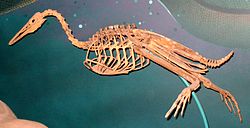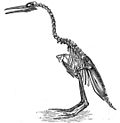Hesperornis
Hesperornis is an extinct genus of flightless aquatic birds that lived during the Upper Cretaceous (89–65 million years ago).
| Hesperornis Temporal range: 89–65 million years ago: Upper Cretaceous
| |
|---|---|

| |
| H. regalis skeleton in swimming pose; note feet pointing sideways. | |
| Scientific classification | |
| Kingdom: | |
| Phylum: | |
| Class: | |
| Subclass: | |
| Family: | |
| Genus: | Hesperornis Marsh, 1872
|
Hesperornis was an important early find in the history of avian paleontology. It was discovered by the paleontologist O.C. Marsh in the late 19th century Bone Wars.
Famous locations for Hesperornis are the Upper Cretaceous marine limestones from Kansas and the marine shales from Canada. The genus probably had a Holarctic distribution.
Anatomy and life style
Hesperornis was a large bird, reaching up to 1.5 meters (5 feet) in length. It had virtually no wings, and swam with its powerful hind legs.
Like many other Mesozoic birds such as Ichthyornis, Hesperornis had teeth in its beak which were used to hold prey (most likely fish).[1][2]
Hesperornis hunted in the waters of such contemporary shelf seas as the North American Inland Sea, the Turgai Strait and the prehistoric North Sea,[3][4] which then were subtropical to tropical waters, much warmer than today. They probably fed mainly on fish, maybe also crustaceans, cephalopods and mollusks, as do the diving seabirds of today. Their teeth were helpful in dealing with slippery or hard-shelled prey.
On land, Hesperornis species may or may not have been able to walk. They certainly could not stand upright like penguins as in the early reconstructions. Their legs attached far at the back and sideways, with even the lower leg being tightly attached to the body (see photo of skeleton). Thus, they were limited to a clumsy hobble at best on land and would have been more nimble if they moved by sliding on their belly or galumphing. The leg skeleton of Hesperornis was so thoroughly adapted to diving that their mode on land, and their egg-laying and parental care, is a matter of speculation.
Young Hesperornis grew fairly quickly and continuously to adulthood, as is the case in modern birds.[5] More young birds are known from the fossil record of the more northerly sites than from those further south. This suggests that at least some species were migratory like today's penguins, which swim polewards in the summer.
Hesperornis was preyed upon by large marine carnivores such as mosasaurs. A Tylosaurus specimen contains the bones of a Hesperornis in its gut area.
Hesperornis Media
References
- ↑ Marsh, Othniel Charles 1880. Odontornithes, a monograph on the extinct toothed birds of North America. Government Printing Office, Washington DC.
- ↑ Gregory, Joseph T. 1952. The jaws of the Cretaceous toothed birds, Ichthyornis and Hesperornis. Condor 54 (2): 73–88. [1]
- ↑ Rees, Jan & Lindgren, Johan 2005. Aquatic birds from the Upper Cretaceous (Lower Campanian) of Sweden and the biology and distribution of hesperornithiforms. Palaeontology 48(6): 1321–1329. (HTML abstract)
- ↑ Hills L.V. et al 1999. Hesperornis (Aves) from Ellesmere Island and palynological correlation of known Canadian localities. Canadian Journal of Earth Sciences 36(9): 1583-1588. HTML abstract Archived 2007-03-11 at the Wayback Machine
- ↑ Chinsamy A; Martin, Larry D. & Dobson P. (1998): Bone microstructure of the diving Hesperornis and the volant Ichthyornis from the Niobrara Chalk of western Kansas. Cretaceous Research 19(2): 225-235. (HTML abstract)



